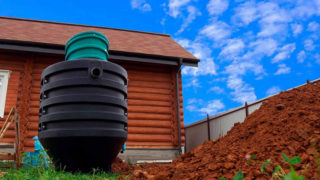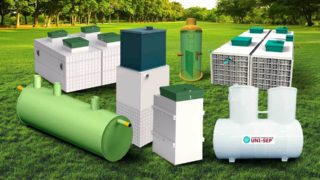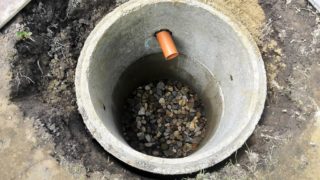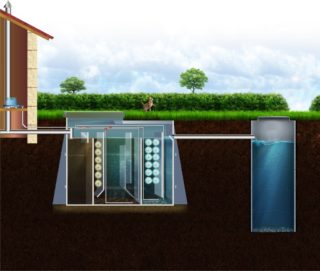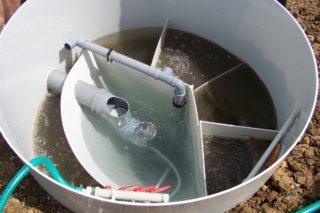The lack of centralized drainage is an acute problem for a private house or summer cottage. It can be solved by installing an effective autonomous sewage system.
Modern autonomous systems for receiving and treating wastewater meet all sanitary standards, do not spoil the landscape of the site, do not exude odors, and do not require frequent sewage disposal. Models of the new generation purify waste water by 95 - 100%, without requiring constant maintenance. Water after such high-quality cleaning can be used for irrigation, and sludge - for soil fertilization.
Which system to choose and in which case
There are three models of autonomous sewerage, depending on the method of operation:
- Cesspools and storage septic tanks.
- Overflow septic tanks.
- Stations with deep biological treatment.
Waste volume
The required volume of overflow septic tanks depends on the amount of water consumed by the family for 1 day. The volume of the septic tank should be 3 times the amount of daily sewage. On average, 1 person uses 200 liters of water per day. This means that a family of 4 people consumes 800 liters of water per day or 0.8 cubic meters. m. We increase this indicator three times and we get the recommended volume of the septic tank 2.4 cubic meters. m. It should be remembered that the receiving tank in the upper part has an overflow into the second tank, so the total volume of the tank will be greater than the volume of three-day wastewater.
Experts recommend installing structures with a volume reserve of up to 30%, since there may be unforeseen increases in water consumption associated with seasonality, the arrival of guests, a change in the number of people permanently residing in the house.
If the daily water consumption exceeds 10 cubic meters. m., it will be necessary to install a three-chamber septic tank for the effective treatment of such a quantity of drains.
Plot size
In areas of a small area occupied by buildings or planted with trees, there may not be enough space for the installation of overflow septic tanks or stations with deep biological treatment. In addition, there is a list of permissible distances from neighboring areas (10 - 12 m), residential buildings (8 - 10 m), water pipes (25 m) and gas pipes (5 m).
Tank material
Most often, when installing an autonomous sewage system, concrete structures are used. It is extremely rare to give preference to metal containers, due to metal corrosion and short service life. You can make a receiver with your own hands from bricks.
Cost of work and materials
A cesspool is the most budgetary option. Installation of more complex structures will cost several times more, because, in addition to the purchase and delivery of materials, it involves the work of special equipment and the involvement of qualified specialists.
Maintenance and care
The cesspool and sealed drive will have to be pumped out regularly (monthly, and sometimes more often). Overflow septic tanks also require cleaning, but not more often than once a year. Only stations with deep biological treatment do not need such maintenance.
Cesspool
Sanitary standards provide for mandatory 2 requirements for cesspools with waste volumes of more than 1 cubic meter. m. per day. This is tightness and the presence of a bottom so that water does not go into the soil and the use of such pits is environmentally friendly.
The cesspool requires regular and fairly frequent cleaning, so you need to choose a place for it on the site that is convenient for the unhindered access of the sewer truck.
Sealed storage
In fact, this is the same cesspool, but in an improved version. A sealed storage tank is a container into which drains are removed from the house and stored until the moment of cleaning. When filling the drive, it is necessary to use the services of sewage equipment and clean the container.
Two-chamber and three-chamber septic tank
The overflow septic tank can also be three-chambered. In this case, the first two tanks serve for the accumulation and settling of water, and drainage takes place from the third well. A more complex design of a three-chamber septic tank provides high-quality water purification, the purification factor can reach 70%. The overflow septic tank model also requires periodic cleaning, usually once a year. With the help of a suction truck, the sediment is cleaned from the first containers (one or two), in which the water settles.
However, not every site can use such a treatment plant. It is inappropriate to install overflow septic tanks on clay soils and with a high level of groundwater occurrence. In the first case, there will be no effective drainage, and in the second, a serious violation of sanitary standards will occur.
Septic tank with filtration field, biological filter and aeration
In the process of purification, wastewater passes through several chambers (receiver, aeration tank, sump and finishing section), each of which has its own function. The receiver serves for the accumulation of effluents and separation of fractions. The process of fine bubble aeration takes place in the aeration tank. The jet pump (airlift) pumps water from the receiver to the aeration tank and actively saturates it with air. In the aerobic tank, aerobic bacteria trigger the decomposition of organic matter. The sump serves as a secondary treatment.
Heavy fractions settle to the bottom and form silt, while light fractions are captured and returned to the aerotank for additional treatment. The finishing section receives water that is almost 100% purified, colorless and odorless. By gravity or with the help of a drainage pump, it is removed from the station into a filtration well, a drainage ditch or into a filtration field. A typical filtration field is an underground structure of drainage pipes laid on a sand and gravel bed with natural fluid movement. It can be used for water purification and in the model of overflow septic tanks.

